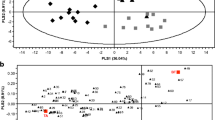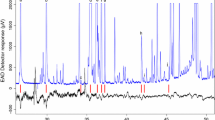Abstract
Plants that are infested by herbivores emit volatile cues that can be used by the natural enemies of the herbivores in their search for hosts. Based on results from behavioral studies, we investigated to what extent intact and herbivore-infested plant species and varieties from the food plant range of Pieris herbivore species differ in the composition of the volatile blends. Parasitoids of Pieris species, Cotesia glomerata and C. rubecula, show differential responses towards various herbivore-infested food plants, whereas differences in responses to plants infested by other herbivore species were less clear. Chemical analysis of the headspace samples of red cabbage, white cabbage, and nasturtium plants that were infested by P. brassicae or P. rapae larvae, or that were intact, yielded 88 compounds including alcohols, ketones, aldehydes, esters, nitriles, terpenoids, sulfides, (iso)thiocyanates, carboxylic acids, and others. The analysis revealed that herbivore-infested plants emit the largest number of compounds in the highest amounts. The plant species affected the volatile blend more than did the herbivore species, and differences between plant varieties were less pronounced than differences between plant species. Differences in headspace composition between plants infested by P. brassicae or P. rapae were mainly of a quantitative nature. Herbivore-infested nasturtium differed considerably from the cabbage varieties in a qualitative way. Headspace compositions of red and white cabbage varieties were comparable to that of the food plant Brussels sprouts (Brassica oleracea gemmifera cv. Titurel) as determined in earlier studies in our laboratory. With respect to plant response to herbivory, nasturtium differed considerably from the cabbage varieties analyzed so far and shows resemblance with Lima bean, cucumber, and corn. These plant species produce a greater quantity and variety of volatiles under herbivore attack than intact plants. The results of this study are discussed in relation to behavioral observations on C. glomerata and C. rubecula.
Similar content being viewed by others
REFERENCES
AGELOPOULOS, N. G., DICKE, M., and POSTHUMUS, M. A. 1995. Role of volatile infochemicals emitted by feces of larvae in host-searching behavior of parasitoid Cotesia rubecula (Hymenoptera: Braconidae): a behavioral and chemical study. J. Chem. Ecol. 21:1789–1811.
AGELOPOULOS, N. G., and KELLER, M. A. 1994. Plant-natural enemy association in the tritrophic system, Cotesia rubecula-Pieris rapae-Brassicaceae (Cruciferae): III. Collection and identification of plant and frass volatiles. J. Chem. Ecol. 20:1955–1967.
BLAAKMEER, A., GEERVLIET, J. B. F., LOON, J. J. A. VAN, POSTHUMUS, M. A., BEEK, T. A. VAN and GROOT, AE. DE. 1994. Comparative headspace analysis of cabbage plants damaged by two species of Pieris caterpillars: Consequences for in-flight host location by Cotesia parasitoids. Entomol. Exp. Appl. 73:175–182.
CHEW, F. S. 1988. Searching for defensive chemistry in the Cruciferae, pp. 81–112, in K. C. Spencer (ed.). Chemical Mediation of Coevolution. Academic Press, San Diego.
DICKE, M. 1994. Local and systemic production of volatile herbivore-induced terpenoids: Their role in plant-carnivore mutualism. J. Plant Physiol. 143:465–472.
DICKE, M. 1998. Evolution of Induced indirect defense of plants. in C. D. Harvell and R. Tollrian (eds.). Evolution of Induced Defenses. Princeton University Press, Princeton, New Jersey. (in press).
DICKE, M., and SABELIS, M. W. 1988. Infochemical terminology: Based on cost-benefit analysis rather than origin of compounds? Funct. Ecol. 2:131–139.
DICKE, M., BEEK, T. A. VAN, POSTHUMUS, M. A., BEN DOM, N., BOKHOVEN, H. VAN, and GROOT, AE. DE. 1990a. Isolation and identification of volatile kairomone that affects acarine predatorprey interactions. Involvement of host plant in its production. J. Chem. Ecol. 16:381–396.
DICKE, M., SABELIS, M. W., TAKABAYASHI, J., BRUIN, J., and POSTHUMUS, M. A. 1990b. Plant strategies of manipulating predator-prey interactions through allelochemicals: Prospects for application in pest control. J. Chem. Ecol. 16:3091–3118.
GEERVLIET, J. B. F., VET, L. E. M., and DICKE, M. 1994. Volatiles from damaged plants as major cues in long-range host-searching by the specialist parasitoid Cotesia rubecula. Entomol. Exp. Appl. 73:289–297.
GEERVLIET, J. B. F., VET, L. E. M., and DICKE, M. 1996. Innate responses of the parasitoids Cotesia glomerata and C. rubecula (Hymenoptera: Braconidae) to volatiles from different plantherbivore complexes. J. Insect Behav. 9:525–538.
GEERVLIET, J. B. F., VREUGDENHIL, A. I., DICKE, M., and VET, L. E. M. 1997a. Learning to discriminate between infochemicals from different plant-host complexes by the parasitoids Cotesia glomerata and C. rubecula. (Hym: Braconidae) Entomol. Exp. Appl. In press.
GEERVLIET, J. B. F., ARIËNS, S. J., DICKE, M., and VET, L. E. M. 1997b. Long-distance assessment of patch profitability through volatile infochemicals by the parasitoids Cotesia glomerata and C. rubecula (Hymenoptera: Braconidae). Biol. Control In press.
GEERVLIET, J. B. F., VERDEL, M. S. W., SNELLEN, H., SCHAUB, J., DICKE, M., and VET, L. E. M. 1997c. Coexistence and niche segregation by field populations of the parasitoids Cotesia glomerata and C. rubecula in the Netherlands: analysis of parasitization and parasitoid behaviour. (submitted).
MATTIACCI, L., DICKE, M., and POSTHUMUS, M. A. 1994. Induction of parasitoid attracting synomone in Brussels sprouts plants by feeding of P. brassicae larvae: Role of mechanical damage and herbivore elicitor. J. Chem. Ecol. 20:2229–2247.
MORAES, G. J. DE, and MCMURTRY, J. A. 1987. Physiological effect of the host plant on the suitability of Tetranychus urticae as prey for Phytoseiulus persimilis (Acari: Tetranychidae, Phytoseiidae). Entomophaga 32:35–38.
PAPAJ, D. R., SNELLEN, H., SWAANS, K., and VET, L. E. M. 1994. Unrewarding experiences and their effect on foraging in the parasitic wasp Leptopilina heterotoma (Hymenoptera: Eucoilidae). J. Insect Behav. 7:465–481.
PRICE, P. W. 1981. Semiochemicals in evolutionary time, pp. 251–271, in D. A. Nordlund, R. L. Jones, and W. J. Lewis (eds.). Semiochemicals, Their Role in Pest Control. Wiley & Sons, New York.
PRICE, P. W., BOUTON, C. E., GROSS, P., MCPHERON, B. A., THOMPSON, J. N., and WEIS, A. E. 1980. Interactions among three trophic levels: Influence of plants of interactions between insect herbivores and natural enemies. Annu. Rev. Ecol. Syst. 11:41–65.
SMITH, B. H. 1993. Merging mechanism and adaptation: An ethological approach to learning and generalization, pp. 126–157, in D. R. Papaj and A. C. Lewis (eds.). Insect Learning. Ecological and Evolutionary Perspectives. Chapman & Hall, New York.
STEINBERG, S., DICKE, M., and VET, L. E. M. 1993. Relative importance of infochemicals from first and second trophic level in long-range host location by larval parasitoid Cotesia glomerata. J. Chem. Ecol. 19:47–59.
TAKABAYASHI, J., and DICKE, M. 1996. Plant-carnivore mutualism through herbivore-induced carnivore attractants. Trends Plant Sci. 1:109–113.
TAKABAYASHI, J., DICKE, M., and POSTHUMUS, M. A. 1991. Variation in composition of predator-attracting allelochemicals emitted by herbivore-infested plants: relative influence of plant and herbivore. Chemoecology 2:1–6.
TAKABAYASHI, J., DICKE, M., and POSTHUMUS, M. A. 1994. Volatile herbivore-induced terpenoids in plant-mite interactions: Variation caused by biotic and abiotic factors. J. Chem. Ecol. 20:1329–1354.
TAKABAYASHI, J., TAKAHASHI, S., DICKE, M., and POSTHUMUS, M. A. 1995. Developmental stage of herbivore Pseudaletia separata affects production of herbivore-induced synomone by corn plants. J. Chem. Ecol. 21:273–287.
TOLLSTEN, L., and BERGSTRÖM, G. 1988. Headspace volatiles of whole plants and macerated plant parts of Brassica and Sinapis. Phytochemistry 27:4013–4018.
TURLINGS, T. C. J., TUMLINSON, J. H., and LEWIS, W. J. 1990. Exploitation of herbivore-induced plant odors by host-seeking parasitic wasps. Science 250:1251–1253.
TURLINGS, T. C. J., WÄCKERS, F. L., VET, L. E. M., LEWIS, W. J., and TUMLINSON, J. H. 1993. Learning of host-finding cues by hymenopterous parasitoids, pp. 51–78, in D. R. Papaj and A. C. Lewis (eds.). Insect Learning—Ecological and Evolutionary Perspectives. Chapman and Hall, New York.
TURLINGS, T. C. J., LOUGHRIN, J. H., MCCALL, P. J., RÖSE, U. S. R., LEWIS, W. J., and TUMLINSON, J. H. 1995. How caterpillar-damaged plants protect themselves by attracting parasitic wasps. Proc. Natl. Acad. Sci. U.S.A. 92:4169–4174.
VET, L. E. M., and DICKE, M. 1992. Infochemical use by natural enemies of herbivores in a tritrophic context. Annu. Rev. Entomol. 37:141–172.
VET, L. E. M., LEWIS, W. J., and CARDÉ, R. T. 1995. Parasitoid foraging and learning, pp. 65–101, in Cardé, R. T. and W. J. Bell (eds.). Chemical Ecology of Insects 2. Chapman and Hall, New York.
VET, L. E. M., DE JONG, A. G., FRANCHI, E., and PAPAJ, D. R. 1997. When to respond to environmental variation: The effect of complete vs incomplete information on odour discrimination in a parasitic wasp. Anim. Behav. In press.
VINSON, S. B. 1981. Habitat location, pp. 51–77, in D. A. Nordlund, R. L. Jones, and W. J. LEWIS (eds.). Semiochemicals—Their Role in Pest Control. John Wiley, New York.
WÄCKERS, F. L., and LEWIS, W. J. 1994. Olfactory and visual learning and their combined influence on host site location by the parasitoid Microplitis croceipes (Cresson). Biol. Contr. 4:105–112.
WHITMAN, D. W., and ELLER, F. J. 1990. Parasitic wasps orient to green leaf volatiles. Chemoecology 1:69–75.
Author information
Authors and Affiliations
Rights and permissions
About this article
Cite this article
Geervliet, J.B.F., Posthumus, M.A., Vet, L.E.M. et al. Comparative Analysis of Headspace Volatiles from Different Caterpillar-Infested or Uninfested Food Plants of Pieris Species. J Chem Ecol 23, 2935–2954 (1997). https://doi.org/10.1023/A:1022583515142
Issue Date:
DOI: https://doi.org/10.1023/A:1022583515142




